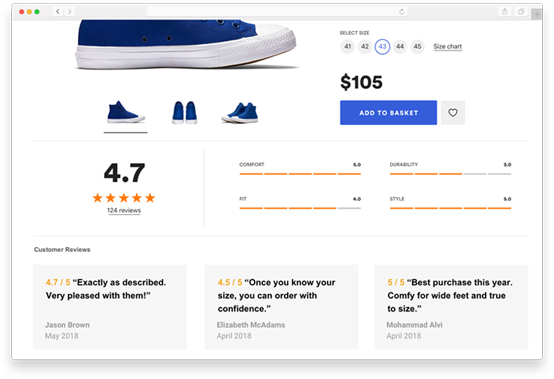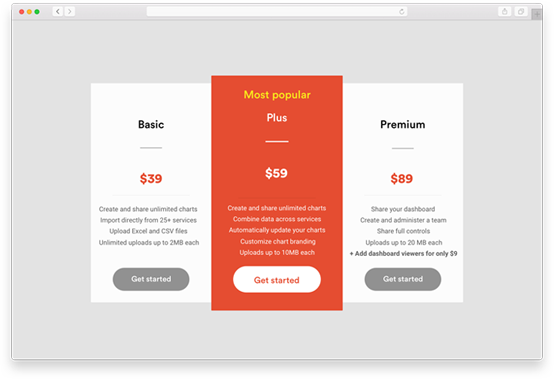Easy website design tricks to boost your e-commerce sales
5-minute read
Visitors coming to your e-commerce website are usually looking to solve a problem or fulfill a desire.
The primary job of your site design is to let them know what you offer and make it easy for them to buy from you.
But you can go further by using design techniques that work on the psychology of visitors to encourage them to buy.
These “tricks of the trade” are widely used by large e-commerce brands and are fundamental to good e-commerce marketing. However, many entrepreneurs aren’t using them and are missing out on sales, says BDC Business Consultant Jessica Horvath.
Horvath says these five design principles and techniques can improve your e-commerce website and increase your sales.
1. Clear and succinct messages
Bold branding and arresting images are important, but some web designs are too focused on visual appeal. The writing is just as important as a beautiful look. You need short, crisp, clear messages that immediately communicate what you offer and why it’s valuable to customers.
Visitors are moving fast and don’t have time to read every word on a page or figure out what cute or impressionistic wording might mean. They scan. Use headlines, bullets and bolding to make your most important messages and calls to action pop out from the page.
“Visitors want to know what benefit they’re going to get from your products or services,” says Horvath, who advises entrepreneurs in Toronto on how to improve their marketing. “The more specific and distinct, the better.”
2. Social proof
Social proof is the idea that people follow the lead of others. Endorsements of your products from customers, experts, celebrities or organizations give psychological comfort to visitors that they’re making a good choice buying from you.
Social proof can take the form of:
- testimonials
- ratings and reviews (think Amazon)
- quality seals and certifications
- client logos (for B2B companies)
- user counts (McDonald’s billions and billion served)
- social media popularity indicators (followers and/or shares)
“Social proof is so important these days because people are evaluating and doing their own research,” Horvath says. “It helps prove what you’re saying: ‘Other people got value from our product or service and so can you.’”

3. Scarcity and loss aversion
Anyone who’s had a time-limited offer dangled in front of them knows it can have a powerful impact. By limiting the availability of products or special offers, you can create a sense of urgency in prospective customers. It can be either in terms of time available for purchase or how many units are available.
“You’re basically pressing on an emotional trigger—the fear of missing out,” Horvath says. “Limited time offers tend to appeal to people with impulsive, emotional triggers. It’s widely used and really works.”
Loss aversion is another closely related concept you can use to increase sales. People tend to prefer avoiding losses than making an equivalent gain. Consider how you could take advantage of this tendency by offering, for example, trials or subscription memberships that run out after a given period of time.

4. Anchoring and extreme aversion
We tend to anchor on extreme options and pick one in between as a compromise. This is why you often see e-commerce sites propose three or four choices to customers ranging from least to most expensive, knowing most will choose a middle option.
Offering a limited number of options can also increase sales because the more choices people have to sift through, the more likely they are to abandon their shopping cart.
“Our attention spans are getting shorter,” Horvath says. “So you need to cut through clutter and provide very limited options so prospective customers can take action.”
At the same time, people like to think they are free to choose. Explicitly stating “it’s your choice” or “you’re free to choose” will often increase conversion rates.
Finally, labeling one of your options as a “customer favourite” can function as an additional social proof signal.

5. Reassurance
People like to feel safe when they make a decision and know they can get out of it if they regret their choice. That’s why guarantees, free shipping, easy return policies and free trials/samples are so popular.
“You want to make the final purchase phase to be as simple as possible. Remove friction and try to make the customer feel good about buying from you.”

Keep on testing
Subtle design changes can have a big impact on your sales. That’s why it’s important to continuously monitor your web analytics data for insights you can use to improve your performance. It’s also a good practice to continuously try new things and gauge the impact.
One way to test your user experience is to bring together a group of target customers to try out your site. You can observe what they do and collect their comments.
Once your site is up and attracting traffic, you can test changes to your design, messaging and navigation to see what hurts or helps sales. You can also do A/B testing—comparing how two versions of a page perform—once you have enough visitors.
“Testing is really important,” Horvath says. “Whenever you’re designing something you have a hypothesis about how something is going to work, but you really don’t know until it goes into the market. Try to understand what’s working and what’s not and make tweaks until its just right.”
Monitoring and testing is an ongoing process - get comfortable with your analytics tools so that you can continue to make informed decisions as your business and customers evolve.